Marketing Strategies of Aldi in the Australian Supermarket Industry
VerifiedAdded on 2020/03/16
|10
|2008
|68
Report
AI Summary
This report provides a comprehensive analysis of Aldi's marketing strategies in the Australian market. It begins with an executive summary and introduction to marketing and Aldi's company background. The core of the report focuses on a market analysis using Porter's Five Forces to evaluate Aldi's position, considering threats of new entrants, substitute products, the bargaining power of suppliers and buyers, and competitive rivalry. The report then delves into Aldi's marketing strategies, highlighting its approach to targeting a broad market, product categorization, and pricing strategies. The report concludes with a discussion of future market strategies, including the continuation of its low-price, high-quality approach, an upgrade of its digital strategy, implementation of e-commerce, and leveraging social media marketing. The report emphasizes the importance of adapting to the demand for fresh products to maintain a competitive edge. The report is referenced with details from various sources to provide a complete understanding of Aldi's business in Australia.

MARKETING – 637208
Paraphrase This Document
Need a fresh take? Get an instant paraphrase of this document with our AI Paraphraser
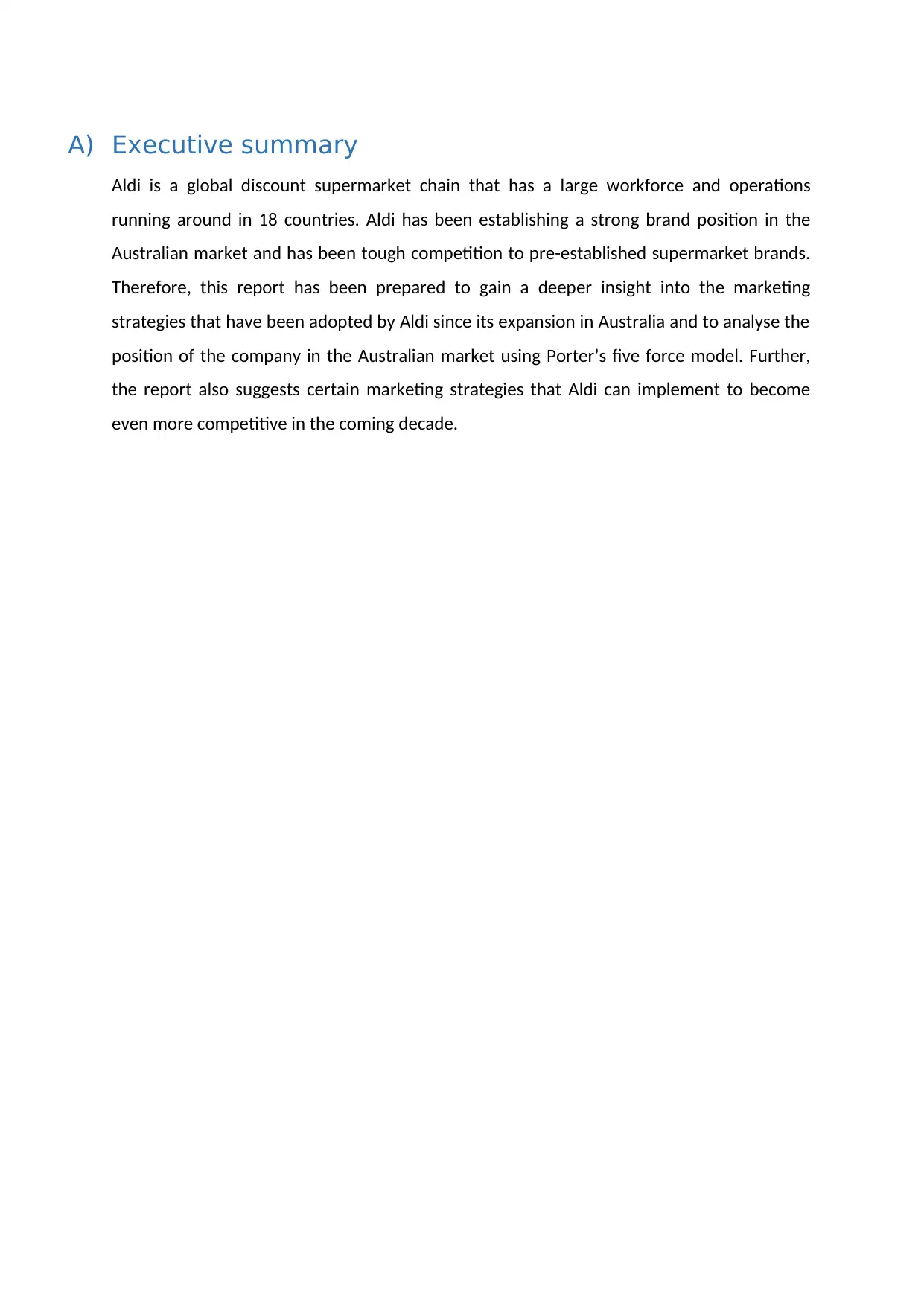
A) Executive summary
Aldi is a global discount supermarket chain that has a large workforce and operations
running around in 18 countries. Aldi has been establishing a strong brand position in the
Australian market and has been tough competition to pre-established supermarket brands.
Therefore, this report has been prepared to gain a deeper insight into the marketing
strategies that have been adopted by Aldi since its expansion in Australia and to analyse the
position of the company in the Australian market using Porter’s five force model. Further,
the report also suggests certain marketing strategies that Aldi can implement to become
even more competitive in the coming decade.
Aldi is a global discount supermarket chain that has a large workforce and operations
running around in 18 countries. Aldi has been establishing a strong brand position in the
Australian market and has been tough competition to pre-established supermarket brands.
Therefore, this report has been prepared to gain a deeper insight into the marketing
strategies that have been adopted by Aldi since its expansion in Australia and to analyse the
position of the company in the Australian market using Porter’s five force model. Further,
the report also suggests certain marketing strategies that Aldi can implement to become
even more competitive in the coming decade.
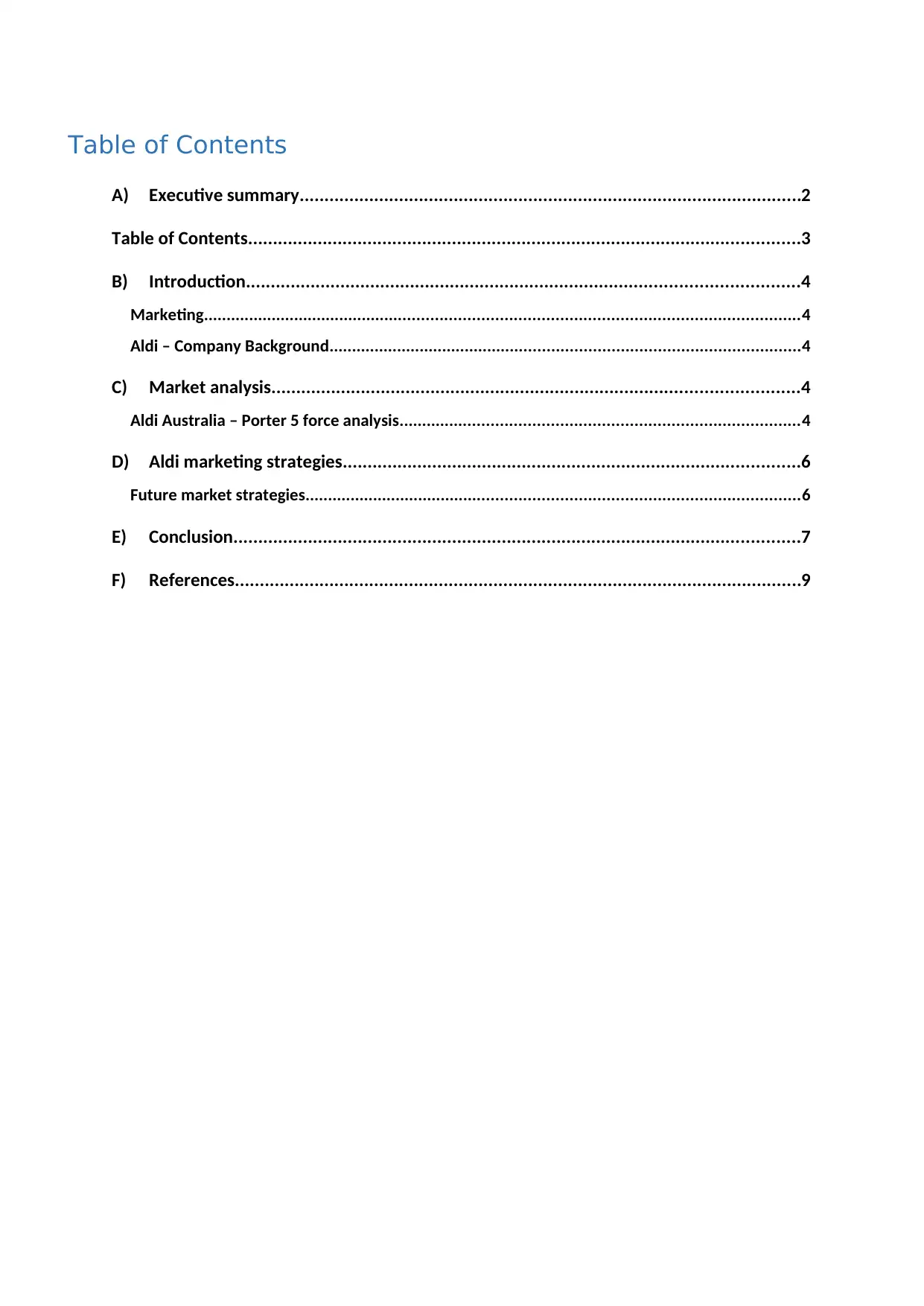
Table of Contents
A) Executive summary.....................................................................................................2
Table of Contents...............................................................................................................3
B) Introduction...............................................................................................................4
Marketing..................................................................................................................................4
Aldi – Company Background.......................................................................................................4
C) Market analysis..........................................................................................................4
Aldi Australia – Porter 5 force analysis.......................................................................................4
D) Aldi marketing strategies............................................................................................6
Future market strategies............................................................................................................6
E) Conclusion..................................................................................................................7
F) References..................................................................................................................9
A) Executive summary.....................................................................................................2
Table of Contents...............................................................................................................3
B) Introduction...............................................................................................................4
Marketing..................................................................................................................................4
Aldi – Company Background.......................................................................................................4
C) Market analysis..........................................................................................................4
Aldi Australia – Porter 5 force analysis.......................................................................................4
D) Aldi marketing strategies............................................................................................6
Future market strategies............................................................................................................6
E) Conclusion..................................................................................................................7
F) References..................................................................................................................9
⊘ This is a preview!⊘
Do you want full access?
Subscribe today to unlock all pages.

Trusted by 1+ million students worldwide
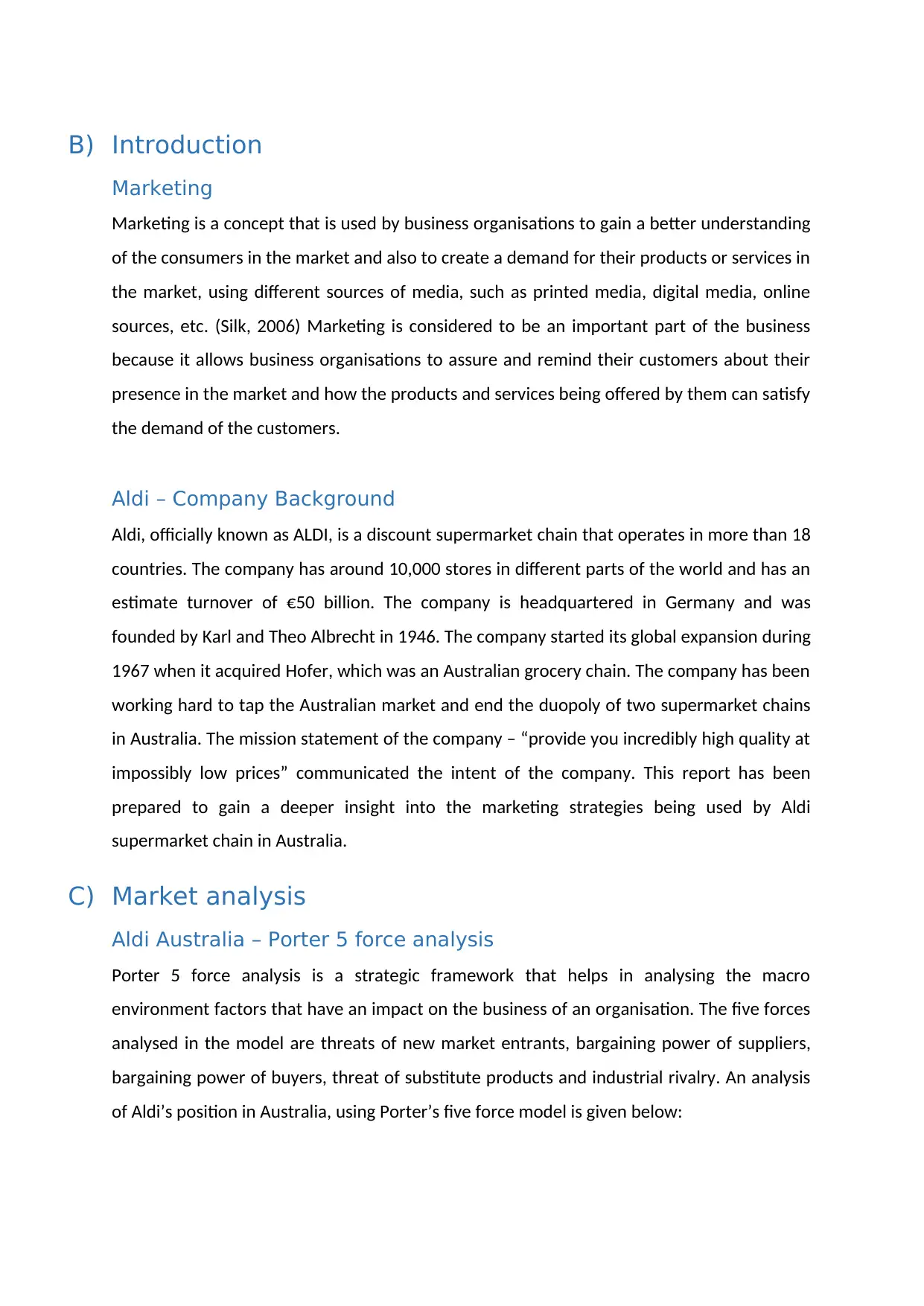
B) Introduction
Marketing
Marketing is a concept that is used by business organisations to gain a better understanding
of the consumers in the market and also to create a demand for their products or services in
the market, using different sources of media, such as printed media, digital media, online
sources, etc. (Silk, 2006) Marketing is considered to be an important part of the business
because it allows business organisations to assure and remind their customers about their
presence in the market and how the products and services being offered by them can satisfy
the demand of the customers.
Aldi – Company Background
Aldi, officially known as ALDI, is a discount supermarket chain that operates in more than 18
countries. The company has around 10,000 stores in different parts of the world and has an
estimate turnover of €50 billion. The company is headquartered in Germany and was
founded by Karl and Theo Albrecht in 1946. The company started its global expansion during
1967 when it acquired Hofer, which was an Australian grocery chain. The company has been
working hard to tap the Australian market and end the duopoly of two supermarket chains
in Australia. The mission statement of the company – “provide you incredibly high quality at
impossibly low prices” communicated the intent of the company. This report has been
prepared to gain a deeper insight into the marketing strategies being used by Aldi
supermarket chain in Australia.
C) Market analysis
Aldi Australia – Porter 5 force analysis
Porter 5 force analysis is a strategic framework that helps in analysing the macro
environment factors that have an impact on the business of an organisation. The five forces
analysed in the model are threats of new market entrants, bargaining power of suppliers,
bargaining power of buyers, threat of substitute products and industrial rivalry. An analysis
of Aldi’s position in Australia, using Porter’s five force model is given below:
Marketing
Marketing is a concept that is used by business organisations to gain a better understanding
of the consumers in the market and also to create a demand for their products or services in
the market, using different sources of media, such as printed media, digital media, online
sources, etc. (Silk, 2006) Marketing is considered to be an important part of the business
because it allows business organisations to assure and remind their customers about their
presence in the market and how the products and services being offered by them can satisfy
the demand of the customers.
Aldi – Company Background
Aldi, officially known as ALDI, is a discount supermarket chain that operates in more than 18
countries. The company has around 10,000 stores in different parts of the world and has an
estimate turnover of €50 billion. The company is headquartered in Germany and was
founded by Karl and Theo Albrecht in 1946. The company started its global expansion during
1967 when it acquired Hofer, which was an Australian grocery chain. The company has been
working hard to tap the Australian market and end the duopoly of two supermarket chains
in Australia. The mission statement of the company – “provide you incredibly high quality at
impossibly low prices” communicated the intent of the company. This report has been
prepared to gain a deeper insight into the marketing strategies being used by Aldi
supermarket chain in Australia.
C) Market analysis
Aldi Australia – Porter 5 force analysis
Porter 5 force analysis is a strategic framework that helps in analysing the macro
environment factors that have an impact on the business of an organisation. The five forces
analysed in the model are threats of new market entrants, bargaining power of suppliers,
bargaining power of buyers, threat of substitute products and industrial rivalry. An analysis
of Aldi’s position in Australia, using Porter’s five force model is given below:
Paraphrase This Document
Need a fresh take? Get an instant paraphrase of this document with our AI Paraphraser
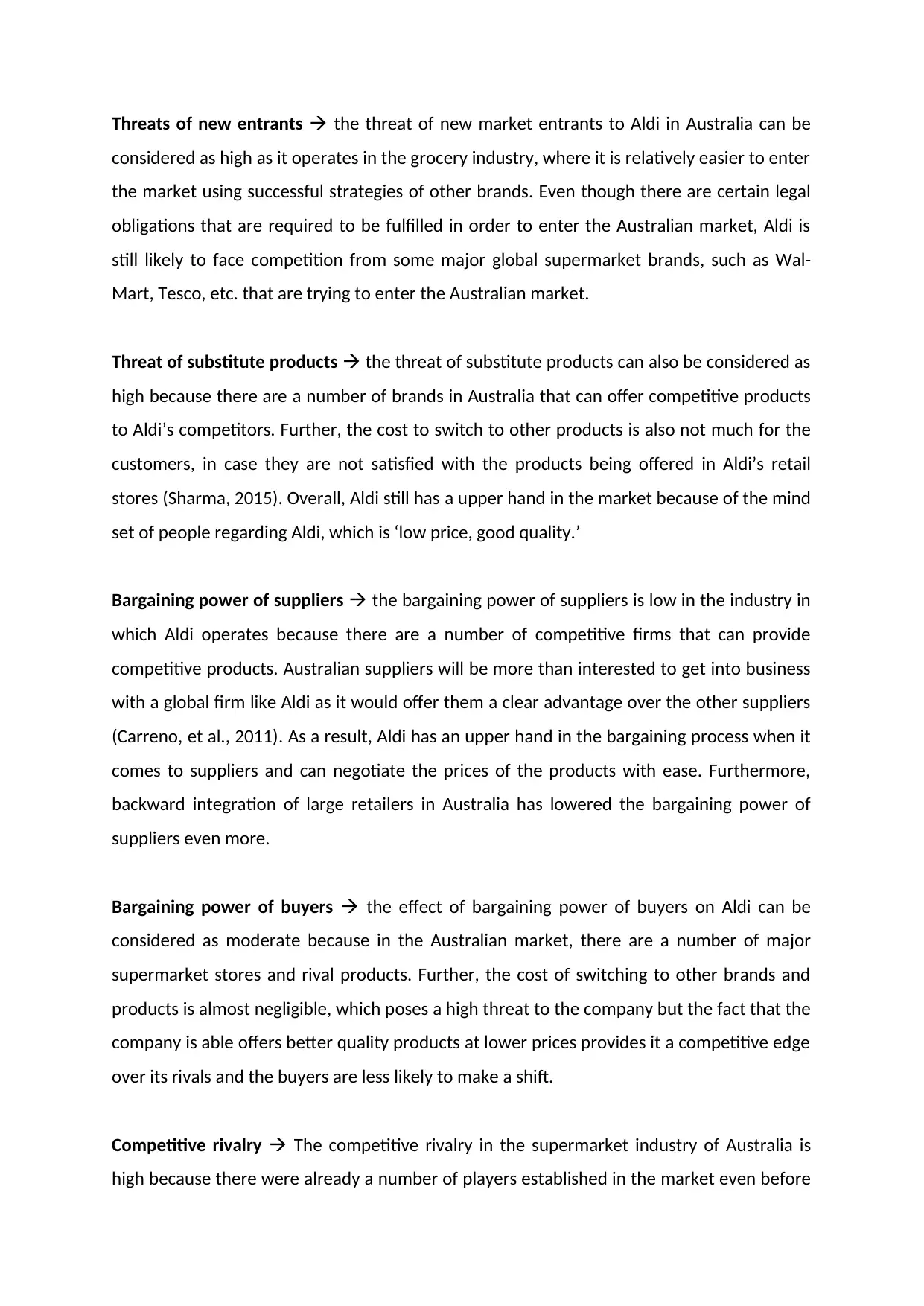
Threats of new entrants the threat of new market entrants to Aldi in Australia can be
considered as high as it operates in the grocery industry, where it is relatively easier to enter
the market using successful strategies of other brands. Even though there are certain legal
obligations that are required to be fulfilled in order to enter the Australian market, Aldi is
still likely to face competition from some major global supermarket brands, such as Wal-
Mart, Tesco, etc. that are trying to enter the Australian market.
Threat of substitute products the threat of substitute products can also be considered as
high because there are a number of brands in Australia that can offer competitive products
to Aldi’s competitors. Further, the cost to switch to other products is also not much for the
customers, in case they are not satisfied with the products being offered in Aldi’s retail
stores (Sharma, 2015). Overall, Aldi still has a upper hand in the market because of the mind
set of people regarding Aldi, which is ‘low price, good quality.’
Bargaining power of suppliers the bargaining power of suppliers is low in the industry in
which Aldi operates because there are a number of competitive firms that can provide
competitive products. Australian suppliers will be more than interested to get into business
with a global firm like Aldi as it would offer them a clear advantage over the other suppliers
(Carreno, et al., 2011). As a result, Aldi has an upper hand in the bargaining process when it
comes to suppliers and can negotiate the prices of the products with ease. Furthermore,
backward integration of large retailers in Australia has lowered the bargaining power of
suppliers even more.
Bargaining power of buyers the effect of bargaining power of buyers on Aldi can be
considered as moderate because in the Australian market, there are a number of major
supermarket stores and rival products. Further, the cost of switching to other brands and
products is almost negligible, which poses a high threat to the company but the fact that the
company is able offers better quality products at lower prices provides it a competitive edge
over its rivals and the buyers are less likely to make a shift.
Competitive rivalry The competitive rivalry in the supermarket industry of Australia is
high because there were already a number of players established in the market even before
considered as high as it operates in the grocery industry, where it is relatively easier to enter
the market using successful strategies of other brands. Even though there are certain legal
obligations that are required to be fulfilled in order to enter the Australian market, Aldi is
still likely to face competition from some major global supermarket brands, such as Wal-
Mart, Tesco, etc. that are trying to enter the Australian market.
Threat of substitute products the threat of substitute products can also be considered as
high because there are a number of brands in Australia that can offer competitive products
to Aldi’s competitors. Further, the cost to switch to other products is also not much for the
customers, in case they are not satisfied with the products being offered in Aldi’s retail
stores (Sharma, 2015). Overall, Aldi still has a upper hand in the market because of the mind
set of people regarding Aldi, which is ‘low price, good quality.’
Bargaining power of suppliers the bargaining power of suppliers is low in the industry in
which Aldi operates because there are a number of competitive firms that can provide
competitive products. Australian suppliers will be more than interested to get into business
with a global firm like Aldi as it would offer them a clear advantage over the other suppliers
(Carreno, et al., 2011). As a result, Aldi has an upper hand in the bargaining process when it
comes to suppliers and can negotiate the prices of the products with ease. Furthermore,
backward integration of large retailers in Australia has lowered the bargaining power of
suppliers even more.
Bargaining power of buyers the effect of bargaining power of buyers on Aldi can be
considered as moderate because in the Australian market, there are a number of major
supermarket stores and rival products. Further, the cost of switching to other brands and
products is almost negligible, which poses a high threat to the company but the fact that the
company is able offers better quality products at lower prices provides it a competitive edge
over its rivals and the buyers are less likely to make a shift.
Competitive rivalry The competitive rivalry in the supermarket industry of Australia is
high because there were already a number of players established in the market even before
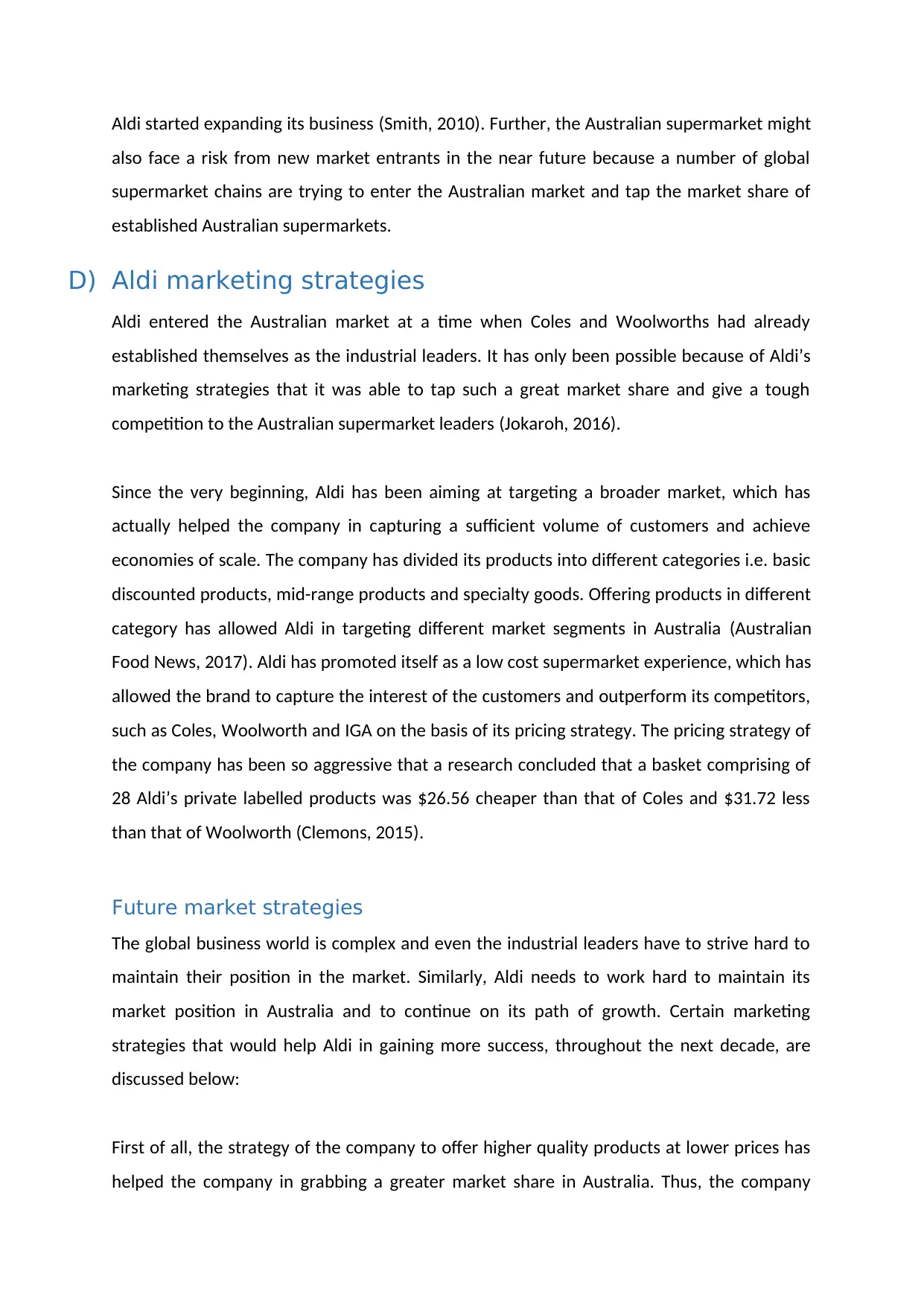
Aldi started expanding its business (Smith, 2010). Further, the Australian supermarket might
also face a risk from new market entrants in the near future because a number of global
supermarket chains are trying to enter the Australian market and tap the market share of
established Australian supermarkets.
D) Aldi marketing strategies
Aldi entered the Australian market at a time when Coles and Woolworths had already
established themselves as the industrial leaders. It has only been possible because of Aldi’s
marketing strategies that it was able to tap such a great market share and give a tough
competition to the Australian supermarket leaders (Jokaroh, 2016).
Since the very beginning, Aldi has been aiming at targeting a broader market, which has
actually helped the company in capturing a sufficient volume of customers and achieve
economies of scale. The company has divided its products into different categories i.e. basic
discounted products, mid-range products and specialty goods. Offering products in different
category has allowed Aldi in targeting different market segments in Australia (Australian
Food News, 2017). Aldi has promoted itself as a low cost supermarket experience, which has
allowed the brand to capture the interest of the customers and outperform its competitors,
such as Coles, Woolworth and IGA on the basis of its pricing strategy. The pricing strategy of
the company has been so aggressive that a research concluded that a basket comprising of
28 Aldi’s private labelled products was $26.56 cheaper than that of Coles and $31.72 less
than that of Woolworth (Clemons, 2015).
Future market strategies
The global business world is complex and even the industrial leaders have to strive hard to
maintain their position in the market. Similarly, Aldi needs to work hard to maintain its
market position in Australia and to continue on its path of growth. Certain marketing
strategies that would help Aldi in gaining more success, throughout the next decade, are
discussed below:
First of all, the strategy of the company to offer higher quality products at lower prices has
helped the company in grabbing a greater market share in Australia. Thus, the company
also face a risk from new market entrants in the near future because a number of global
supermarket chains are trying to enter the Australian market and tap the market share of
established Australian supermarkets.
D) Aldi marketing strategies
Aldi entered the Australian market at a time when Coles and Woolworths had already
established themselves as the industrial leaders. It has only been possible because of Aldi’s
marketing strategies that it was able to tap such a great market share and give a tough
competition to the Australian supermarket leaders (Jokaroh, 2016).
Since the very beginning, Aldi has been aiming at targeting a broader market, which has
actually helped the company in capturing a sufficient volume of customers and achieve
economies of scale. The company has divided its products into different categories i.e. basic
discounted products, mid-range products and specialty goods. Offering products in different
category has allowed Aldi in targeting different market segments in Australia (Australian
Food News, 2017). Aldi has promoted itself as a low cost supermarket experience, which has
allowed the brand to capture the interest of the customers and outperform its competitors,
such as Coles, Woolworth and IGA on the basis of its pricing strategy. The pricing strategy of
the company has been so aggressive that a research concluded that a basket comprising of
28 Aldi’s private labelled products was $26.56 cheaper than that of Coles and $31.72 less
than that of Woolworth (Clemons, 2015).
Future market strategies
The global business world is complex and even the industrial leaders have to strive hard to
maintain their position in the market. Similarly, Aldi needs to work hard to maintain its
market position in Australia and to continue on its path of growth. Certain marketing
strategies that would help Aldi in gaining more success, throughout the next decade, are
discussed below:
First of all, the strategy of the company to offer higher quality products at lower prices has
helped the company in grabbing a greater market share in Australia. Thus, the company
⊘ This is a preview!⊘
Do you want full access?
Subscribe today to unlock all pages.

Trusted by 1+ million students worldwide
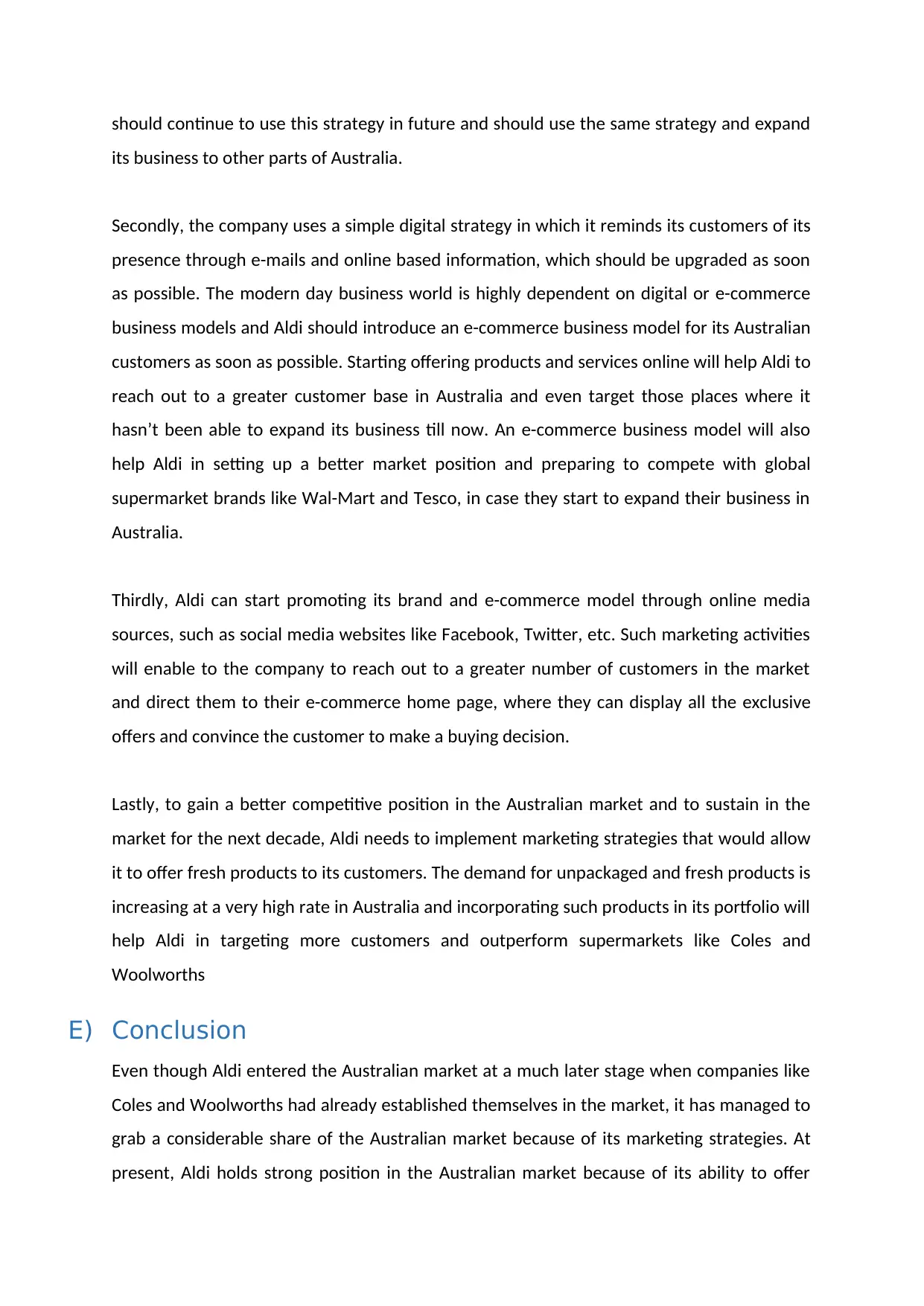
should continue to use this strategy in future and should use the same strategy and expand
its business to other parts of Australia.
Secondly, the company uses a simple digital strategy in which it reminds its customers of its
presence through e-mails and online based information, which should be upgraded as soon
as possible. The modern day business world is highly dependent on digital or e-commerce
business models and Aldi should introduce an e-commerce business model for its Australian
customers as soon as possible. Starting offering products and services online will help Aldi to
reach out to a greater customer base in Australia and even target those places where it
hasn’t been able to expand its business till now. An e-commerce business model will also
help Aldi in setting up a better market position and preparing to compete with global
supermarket brands like Wal-Mart and Tesco, in case they start to expand their business in
Australia.
Thirdly, Aldi can start promoting its brand and e-commerce model through online media
sources, such as social media websites like Facebook, Twitter, etc. Such marketing activities
will enable to the company to reach out to a greater number of customers in the market
and direct them to their e-commerce home page, where they can display all the exclusive
offers and convince the customer to make a buying decision.
Lastly, to gain a better competitive position in the Australian market and to sustain in the
market for the next decade, Aldi needs to implement marketing strategies that would allow
it to offer fresh products to its customers. The demand for unpackaged and fresh products is
increasing at a very high rate in Australia and incorporating such products in its portfolio will
help Aldi in targeting more customers and outperform supermarkets like Coles and
Woolworths
E) Conclusion
Even though Aldi entered the Australian market at a much later stage when companies like
Coles and Woolworths had already established themselves in the market, it has managed to
grab a considerable share of the Australian market because of its marketing strategies. At
present, Aldi holds strong position in the Australian market because of its ability to offer
its business to other parts of Australia.
Secondly, the company uses a simple digital strategy in which it reminds its customers of its
presence through e-mails and online based information, which should be upgraded as soon
as possible. The modern day business world is highly dependent on digital or e-commerce
business models and Aldi should introduce an e-commerce business model for its Australian
customers as soon as possible. Starting offering products and services online will help Aldi to
reach out to a greater customer base in Australia and even target those places where it
hasn’t been able to expand its business till now. An e-commerce business model will also
help Aldi in setting up a better market position and preparing to compete with global
supermarket brands like Wal-Mart and Tesco, in case they start to expand their business in
Australia.
Thirdly, Aldi can start promoting its brand and e-commerce model through online media
sources, such as social media websites like Facebook, Twitter, etc. Such marketing activities
will enable to the company to reach out to a greater number of customers in the market
and direct them to their e-commerce home page, where they can display all the exclusive
offers and convince the customer to make a buying decision.
Lastly, to gain a better competitive position in the Australian market and to sustain in the
market for the next decade, Aldi needs to implement marketing strategies that would allow
it to offer fresh products to its customers. The demand for unpackaged and fresh products is
increasing at a very high rate in Australia and incorporating such products in its portfolio will
help Aldi in targeting more customers and outperform supermarkets like Coles and
Woolworths
E) Conclusion
Even though Aldi entered the Australian market at a much later stage when companies like
Coles and Woolworths had already established themselves in the market, it has managed to
grab a considerable share of the Australian market because of its marketing strategies. At
present, Aldi holds strong position in the Australian market because of its ability to offer
Paraphrase This Document
Need a fresh take? Get an instant paraphrase of this document with our AI Paraphraser
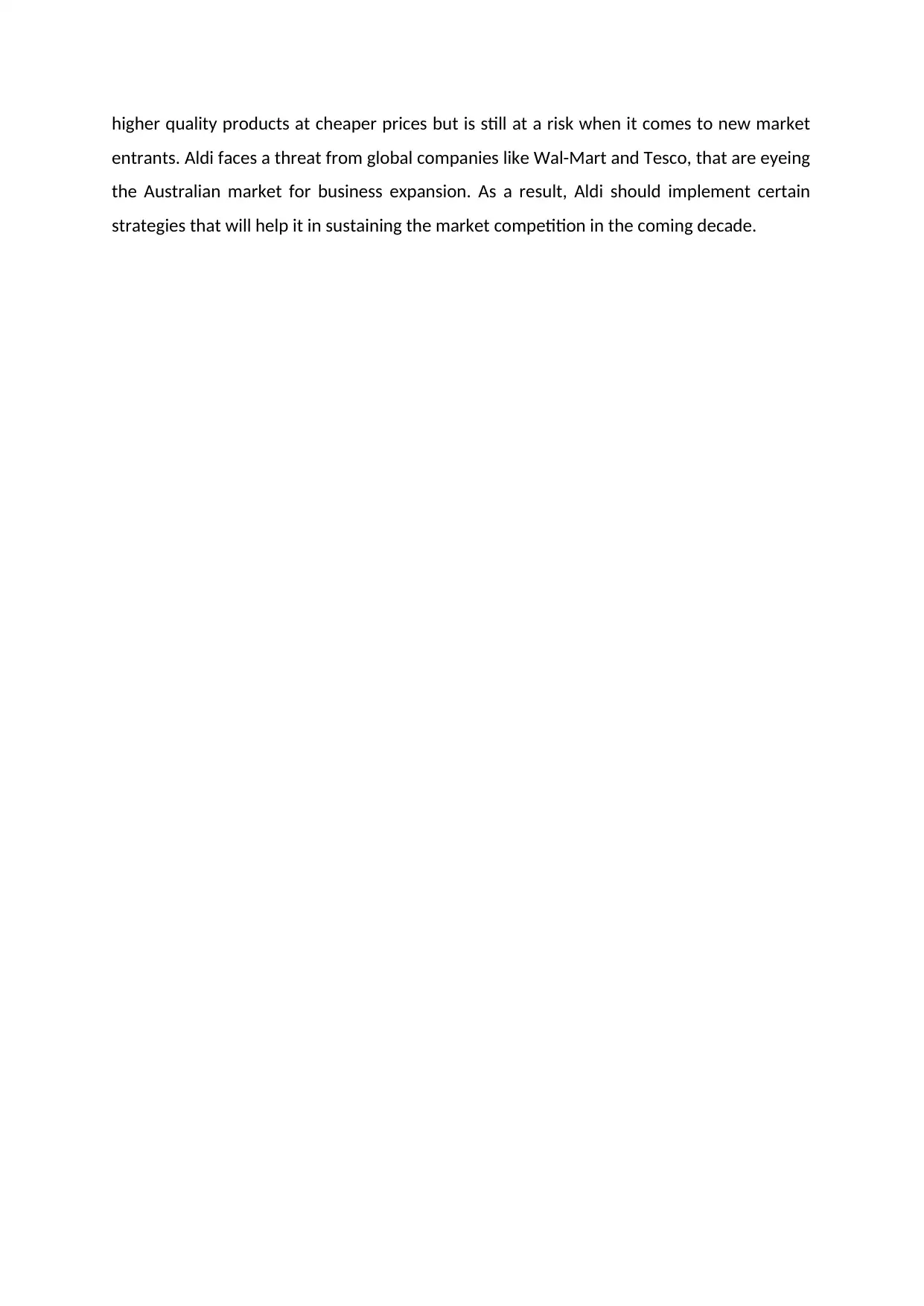
higher quality products at cheaper prices but is still at a risk when it comes to new market
entrants. Aldi faces a threat from global companies like Wal-Mart and Tesco, that are eyeing
the Australian market for business expansion. As a result, Aldi should implement certain
strategies that will help it in sustaining the market competition in the coming decade.
entrants. Aldi faces a threat from global companies like Wal-Mart and Tesco, that are eyeing
the Australian market for business expansion. As a result, Aldi should implement certain
strategies that will help it in sustaining the market competition in the coming decade.
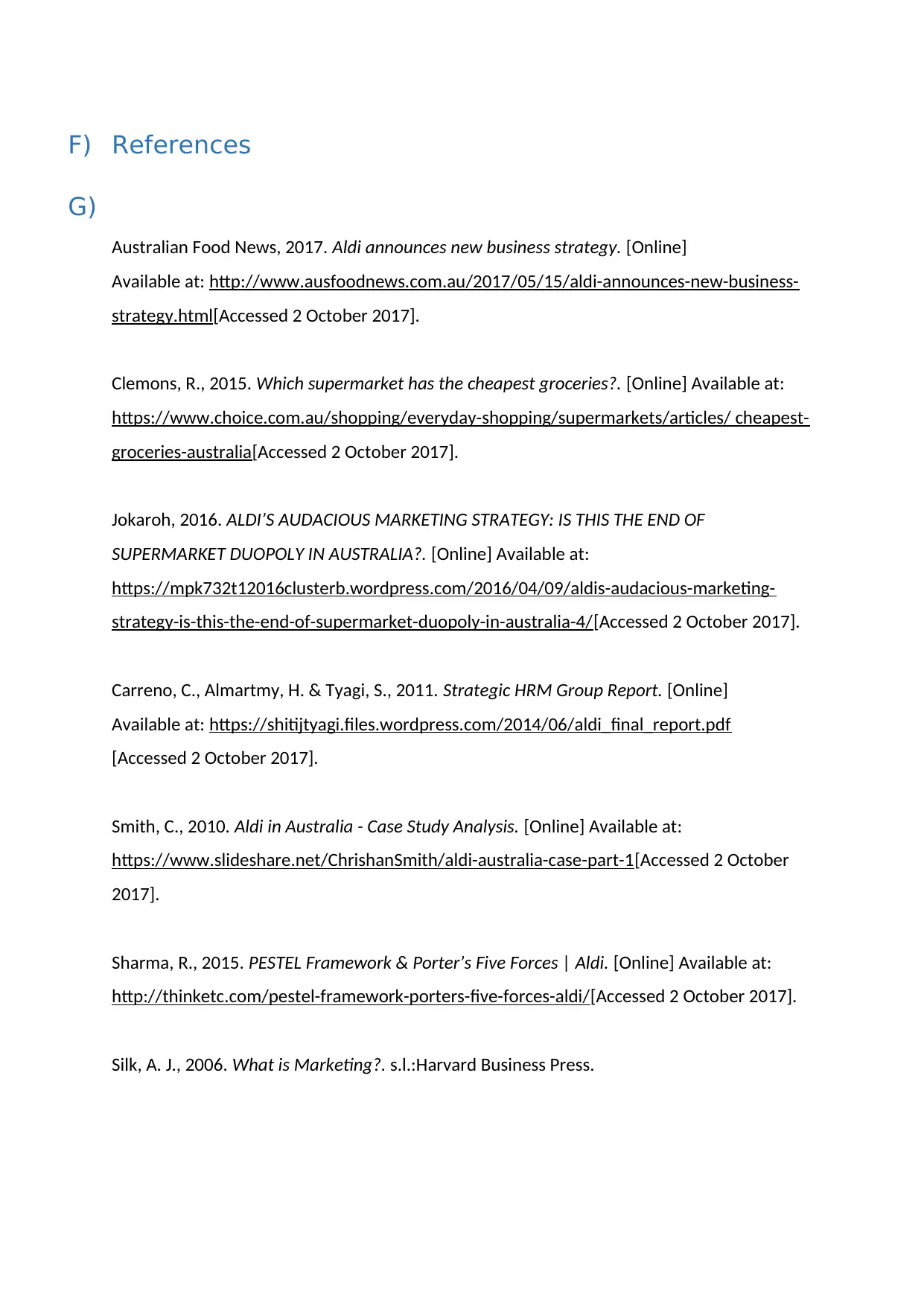
F) References
G)
Australian Food News, 2017. Aldi announces new business strategy. [Online]
Available at: http://www.ausfoodnews.com.au/2017/05/15/aldi-announces-new-business-
strategy.html[Accessed 2 October 2017].
Clemons, R., 2015. Which supermarket has the cheapest groceries?. [Online] Available at:
https://www.choice.com.au/shopping/everyday-shopping/supermarkets/articles/ cheapest-
groceries-australia[Accessed 2 October 2017].
Jokaroh, 2016. ALDI’S AUDACIOUS MARKETING STRATEGY: IS THIS THE END OF
SUPERMARKET DUOPOLY IN AUSTRALIA?. [Online] Available at:
https://mpk732t12016clusterb.wordpress.com/2016/04/09/aldis-audacious-marketing-
strategy-is-this-the-end-of-supermarket-duopoly-in-australia-4/[Accessed 2 October 2017].
Carreno, C., Almartmy, H. & Tyagi, S., 2011. Strategic HRM Group Report. [Online]
Available at: https://shitijtyagi.files.wordpress.com/2014/06/aldi_final_report.pdf
[Accessed 2 October 2017].
Smith, C., 2010. Aldi in Australia - Case Study Analysis. [Online] Available at:
https://www.slideshare.net/ChrishanSmith/aldi-australia-case-part-1[Accessed 2 October
2017].
Sharma, R., 2015. PESTEL Framework & Porter’s Five Forces | Aldi. [Online] Available at:
http://thinketc.com/pestel-framework-porters-five-forces-aldi/[Accessed 2 October 2017].
Silk, A. J., 2006. What is Marketing?. s.l.:Harvard Business Press.
G)
Australian Food News, 2017. Aldi announces new business strategy. [Online]
Available at: http://www.ausfoodnews.com.au/2017/05/15/aldi-announces-new-business-
strategy.html[Accessed 2 October 2017].
Clemons, R., 2015. Which supermarket has the cheapest groceries?. [Online] Available at:
https://www.choice.com.au/shopping/everyday-shopping/supermarkets/articles/ cheapest-
groceries-australia[Accessed 2 October 2017].
Jokaroh, 2016. ALDI’S AUDACIOUS MARKETING STRATEGY: IS THIS THE END OF
SUPERMARKET DUOPOLY IN AUSTRALIA?. [Online] Available at:
https://mpk732t12016clusterb.wordpress.com/2016/04/09/aldis-audacious-marketing-
strategy-is-this-the-end-of-supermarket-duopoly-in-australia-4/[Accessed 2 October 2017].
Carreno, C., Almartmy, H. & Tyagi, S., 2011. Strategic HRM Group Report. [Online]
Available at: https://shitijtyagi.files.wordpress.com/2014/06/aldi_final_report.pdf
[Accessed 2 October 2017].
Smith, C., 2010. Aldi in Australia - Case Study Analysis. [Online] Available at:
https://www.slideshare.net/ChrishanSmith/aldi-australia-case-part-1[Accessed 2 October
2017].
Sharma, R., 2015. PESTEL Framework & Porter’s Five Forces | Aldi. [Online] Available at:
http://thinketc.com/pestel-framework-porters-five-forces-aldi/[Accessed 2 October 2017].
Silk, A. J., 2006. What is Marketing?. s.l.:Harvard Business Press.
⊘ This is a preview!⊘
Do you want full access?
Subscribe today to unlock all pages.

Trusted by 1+ million students worldwide

1 out of 10
Related Documents
Your All-in-One AI-Powered Toolkit for Academic Success.
+13062052269
info@desklib.com
Available 24*7 on WhatsApp / Email
![[object Object]](/_next/static/media/star-bottom.7253800d.svg)
Unlock your academic potential
Copyright © 2020–2025 A2Z Services. All Rights Reserved. Developed and managed by ZUCOL.





